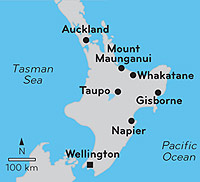After joining the Robertsons for a prodigious breakfast, I set off again along State Highway 2, cruising southeast toward Gisborne, on the island’s far coast. The road turns inland before rejoining the Bay of Plenty, where it is framed by chiseled white cliffs and the vast blue of the Pacific. It’s a suitably pacific scene—until a small bird ricochets off my windshield with a disheartening crack. Guiltily, I press on, whizzing though Matata, a community so small it doesn’t warrant a mention in my guidebook, and past the flat-topped volcanic cone of Putauaki (Mount Edgecumbe), which does.
Still distracted by my avian hit-and-run, I miss a turnoff and end up in Whakatane. (It’s perhaps worth noting at this point that the aspirated “wh” in Maori words is pronounced like a soft “f” by pakeha—non-Maori—Kiwis. This proved burdensome to Whakatane’s district council a few years back when it was discovered that phonetic content filters were censoring the town’s name in cyberspace.) Like the other towns I’ve driven through so far, Whakatane has roundabouts instead of intersections; come to think of it, I can’t remember the last time I saw a traffic light. I decide to stop anyway; I’ve been driving for two hours, and a roadside shack advertising oysters beckons. A young guy in gum boots shucks me half a dozen Ohiwa oysters on the spot, and hands me a can of ginger beer to wash them down with.
I still have some way to go before Gisborne: another 200 kilometers or so. A good chunk of that runs through Waioeka Gorge, one of the country’s largest scenic reserves. The road twists along the gorge’s forested flanks, climbing higher and higher into the mist. When I pull over to take in the hazy views of the valley below, a chill wind bites through my jacket. Absently, I notice that the reception on my mobile phone has cut out.
All too soon, civilization reasserts itself, as the road begins its descent through rolling hills that have been grazed to stubble by sheep and cattle. I round a corner, and a sparkling ribbon of ocean signals the end of the day’s journey.
Gisborne, New Zealand’s most easterly city, has a couple of bragging rights. Due to its proximity to the International Date Line, it claims to be the first city in the world to see the sun rise on any given day. Secondly, it was here, in 1769, that Captain Cook first stepped ashore in New Zealand. Though no hero to the Maori—several native warriors were killed during their first encounter with the British, a harbinger of bad times to come—Cook is memorialized throughout town, from a brick lookout atop Kaiti Hill called Cook’s Plaza, to a century-old granite obelisk marking his landing point (now marooned behind wharf-side warehouses), to a bronze statue of the explorer himself astride a globe, his back turned to Poverty Bay, as he unflatteringly named his first New Zealand anchorage.
There’s time enough to tour all these sights before dinner, and to poke my head in at the Te Poho o Rawiri marae (meeting place), whose carved gables and richly embellished interiors offer a fine counterpoint. Later, over a plate of duck confit and a carafe of lush, local Gewurztraminer at the riverside Marina Restaurant, I decide that I could get to like Gisborne—or Gizzie, as the locals call it—quite a bit. But the city’s easygoing vibe and small-town character apparently have their limits. In the newspaper, I read about the sentencing of four members of a local Maori gang called the Mongrel Mob, who were involved in a confrontation with members of the rival Black Power gang. I ask the night clerk at my hotel about it.
“Happens every once in a while,” he says. “Have you ever seen the movie Once Were Warriors? Lots of big guys with tattoos and anger issues and too much to drink. It’s kinda like that. But the bad apples keep to themselves. Gizzie’s still a great place to raise a family.”
Eager to see the new day dawn before the other 6.8 billion people on the planet, I wake early the next morning and drive in the dark up to Wainui Beach. Alas, the weather is overcast and drizzly. I tough it out anyway, hunkering down on the wet sand until about 6 a.m., when I judge from the thin gray light that the sun has already risen behind the cloudbank on the horizon.
It’s a good four hours’ drive from Gizzie to the southern reaches of Hawke Bay, but after a couple of pit stops, I finally make it to Napier, a self-styled “Art Deco City” of about 60,000 people. In the summer of 1931, Napier was almost completely flattened by a magnitude-7.8 earthquake. The doughty townsfolk vowed to rebuild, and in just two years a new city center had risen, built entirely in the Art Deco style that was then sweeping the world.
I join a walking tour organized by the nonprofit Art Deco Trust. It takes in three or four blocks, all lined with decorative facades sporting bas-relief flourishes like sunbursts, zigzags, even some Maori motifs. I might have lingered, but I’m in a hurry to make my lunch reservation at Elephant Hill Estate, the newest winery in a region renowned for its wines. Set on the coast just shy of Cape Kidnappers (also named by an unhappy Cook, after the near abduction of his Tahitian interpreter), the estate’s main building is hard to miss among the seaside vineyards: it’s a boxy affair sheathed in glass and verdigris-green copper and fronted, for no discernible reason, by a statue of a Thai war elephant. From my seat in the oak-floored restaurant, the views across the grapevines to the ocean are memoraable. And so is my meal: crab cakes paired with a glass of silken Viognier; twice-cooked pork fillet with shallot jam and Elephant Hill’s 2008 Syrah; and a pineapple-polenta pudding chased down with some of the estate’s lively Pinot rosé.
After all that, it’s a good thing my digs for the night are right next door—well, as much as 2,400 hectares of bush and pastureland can be considered next door to anywhere. The Farm at Cape Kidnappers, which sprawls on a bluff above its namesake headland, is one of New Zealand’s most exclusive addresses; to my chagrin, I have to borrow a dinner jacket before taking a seat in the dining room. Yet it also offers a very accessible brand of luxury, from a handsome main lodge decorated with farm tools and other rustic artifacts, to enormous, honey-toned suites that look out onto unbridled sea views. When I turn in for the night, it doesn’t take long for me to slip into a deep, contented sleep.










